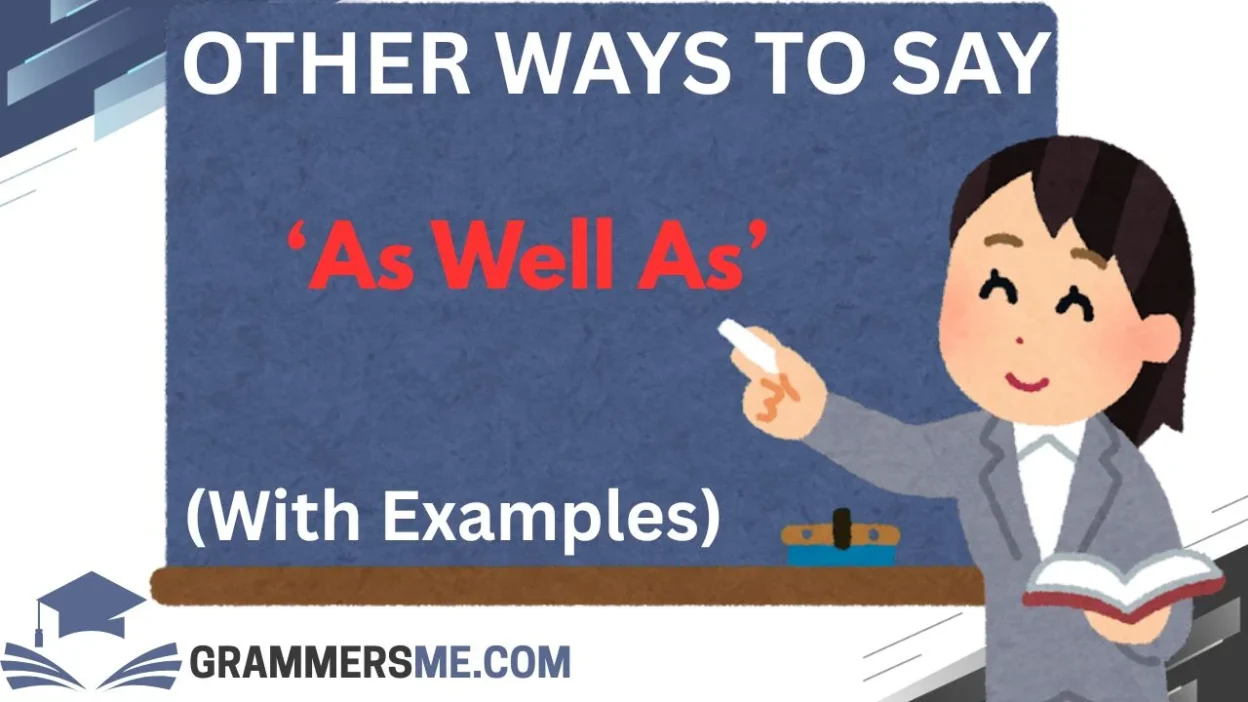When we communicate with warmth and intention, even small phrases can carry big meaning. One such phrase is “as well as”—a gentle connector that adds depth, collaboration, and inclusion to our messages. Whether you’re writing an email, crafting a thoughtful note, or expressing yourself professionally or personally, finding the right alternative can make all the difference.
This guide offers 30 thoughtful, warm, and human-centered alternatives to “as well as,” with examples and guidance to help you communicate with clarity and care.
What Does “As Well As” Mean?
Meaning: The phrase “as well as” is used to add something to a statement without making it sound like a simple list. It connects two ideas in a soft, non-intrusive way, often used when you want to emphasize both parts with equal importance.
Explanation: It’s more graceful than simply saying “and,” especially when used in writing. It offers a touch of elegance, making the sentence feel more thoughtful or complete.
Example: She excels in design as well as communication.
Tone: Polite, formal to semi-formal, inclusive.
Is It Professional/Polite to Say “As Well As”?
Yes, absolutely. “As well as” is both professional and polite. It’s widely used in business emails, presentations, reports, and personal communication when you want to add another point without making the message sound too abrupt or transactional.
1. In Addition To
Meaning: Adds more information to a statement.
Explanation: This phrase is commonly used in formal and academic writing. It implies that something extra or additional is being included.
Example: In addition to her teaching skills, she’s an incredible mentor.
Best Use: In emails, reports, presentations, or formal proposals.
Not Use: Avoid in very casual conversations—can sound overly stiff.
2. Along With
Meaning: To go together with something.
Explanation: Offers a gentle and more conversational alternative. It emphasizes togetherness and shared value.
Example: He submitted the budget report along with the marketing plan.
Best Use: Great for teamwork, group contexts, and collaborative tasks.
Not Use: Avoid when you need high-formality or legal precision.
3. Together With
Meaning: Indicates that multiple things exist or are done jointly.
Explanation: Slightly more formal than “along with” but still warm and collaborative.
Example: Together with our partners, we’re launching a new initiative.
Best Use: Strategic plans, mission statements, group acknowledgments.
Not Use: In fast-paced casual convos—it may feel too formal.
4. And Also
Meaning: Reinforces an additional point.
Explanation: Slightly repetitive but can be effective for emphasis in speech or informal writing.
Example: She’s great with numbers and also skilled in storytelling.
Best Use: Personal messages, casual writing.
Not Use: In concise or professional writing—it can feel redundant.
5. As Much As
Meaning: Shows equal importance or emphasis.
Explanation: Highlights a balance between two ideas or qualities.
Example: He values creativity as much as he values structure.
Best Use: Reflections, opinions, or personal assessments.
Not Use: Avoid in technical or data-heavy writing.
6. Plus
Meaning: Adds something in an informal way.
Explanation: Simple and to the point—often used in speech and casual writing.
Example: We’re bringing snacks, plus games and music!
Best Use: Texts, friendly notes, marketing.
Not Use: Avoid in formal documents or academic work.
7. Not to Mention
Meaning: Emphasizes something worth noting.
Explanation: A bit more emotional—adds a thoughtful or slightly dramatic flair.
Example: She’s incredibly sharp, not to mention hilarious.
Best Use: Stories, speeches, blog posts.
Not Use: Professional emails—it can sound too personal or dramatic.
8. Coupled With
Meaning: Suggests a strong combination.
Explanation: Often used when two things together produce a stronger result.
Example: Her passion, coupled with her discipline, makes her unstoppable.
Best Use: Motivational messages, evaluations, or proposals.
Not Use: In everyday casual conversation—it sounds too intense.
9. Together
Meaning: Indicates a joint effort or presence.
Explanation: Short and warm—it adds a feeling of unity.
Example: They tackled the problem together with empathy and patience.
Best Use: Team-oriented communication, supportive messages.
Not Use: Avoid when discussing abstract or technical subjects.
10. Added To That
Meaning: Builds on a previous point.
Explanation: Shows a natural extension of an idea or list.
Example: She brings years of experience. Added to that, she’s a fantastic leader.
Best Use: Transitioning in writing, storytelling, or summaries.
Not Use: In highly formal reports—it can feel too conversational.
11. In Like Manner
Meaning: In a similar or comparable way.
Explanation: This phrase connects ideas that are aligned or parallel, giving your message a more formal and reflective tone.
Example: He leads with empathy; in like manner, his team follows with loyalty.
Best Use: Speeches, reflective writing, essays. Not Use: Avoid in casual conversation—it feels a bit old-fashioned.
12. More Than That
Meaning: Emphasizes an even greater addition.
Explanation: Adds emotional weight or significance to your statement, often highlighting something impressive.
Example: She’s organized. More than that, she’s inspiring.
Best Use: Praise, storytelling, heartfelt communication. Not Use: Business reports—it can feel too sentimental.
13. On Top of That
Meaning: Adds another point with emphasis.
Explanation: Common in casual and enthusiastic tones, it implies that something extra is being added, often with surprise or delight.
Example: He finished early, and on top of that, he volunteered to help others.
Best Use: Emails, informal writing, personal messages. Not Use: Avoid in academic or highly formal settings.
14. Besides That
Meaning: Used to add supporting or additional information.
Explanation: Gentle and fluid, it helps move from one point to another without sounding too rigid.
Example: She’s an expert in HR. Besides that, she’s wonderful with conflict resolution.
Best Use: Conversational emails, coaching, storytelling. Not Use: Highly structured business documents.
15. In the Same Way
Meaning: Shows a parallel or mirrored idea.
Explanation: Highlights consistency or a shared value between two elements.
Example: The client values transparency. In the same way, our team practices openness.
Best Use: Reports, reflections, mission statements. Not Use: Avoid in quick texts—it can sound too polished.
16. As Well
Meaning: A shorter, casual variation of “as well as.”
Explanation: Great for adding something at the end of a sentence in a soft, non-intrusive way.
Example: I’ll be joining the meeting as well.
Best Use: Everyday conversations, casual emails. Not Use: As a replacement at the beginning or middle of complex sentences.
17. Moreover
Meaning: Adds a new and often stronger point.
Explanation: A more formal connector, great for persuasive or structured writing.
Example: She’s an excellent developer. Moreover, she trains junior staff.
Best Use: Essays, proposals, formal writing. Not Use: Texts or friendly chat—it sounds too stiff.
18. Too
Meaning: A casual and concise addition.
Explanation: Works well when you want to add something lightly without making it sound bulky.
Example: He enjoys hiking. I do, too.
Best Use: Friendly messages, casual communication. Not Use: Professional or structured writing—it may sound too informal.
19. Further
Meaning: Indicates something in addition to what’s been said.
Explanation: A smart, clean way to elevate your writing by introducing a new yet connected point.
Example: Further, we believe these strategies will improve retention.
Best Use: Formal writing, research, or academic papers. Not Use: Casual chats or social media posts.
20. Equally
Meaning: Emphasizes that two things are just as important.
Explanation: Good for balanced comparisons or highlighting dual importance.
Example: She’s equally strong in analytics and communication.
Best Use: Evaluations, feedback, thoughtful writing. Not Use: Don’t use when the elements aren’t balanced—it could mislead.
21. Over and Above
Meaning: Indicates something that exceeds expectations.
Explanation: Slightly poetic, it gives your sentence a richer tone.
Example: Over and above her usual duties, she mentored three interns.
Best Use: Appreciations, speeches, and warm acknowledgments. Not Use: Technical or legal documents—it may sound flowery.
22. What’s More
Meaning: Adds emphasis or a surprising detail.
Explanation: Has a conversational and slightly dramatic flair.
Example: The project was on time. What’s more, it came under budget.
Best Use: Presentations, storytelling, newsletters. Not Use: Legal writing or technical documents.
23. Let Alone
Meaning: Used to emphasize contrast or something unexpected.
Explanation: It implies that if one thing is true, the next is even more surprising.
Example: He hasn’t read the email, let alone responded to it.
Best Use: Informal writing, conversational tone. Not Use: Structured arguments or praise—it can feel too critical.
24. Including
Meaning: Adds items or qualities to a group.
Explanation: Straightforward and inclusive, ideal for listing or specifying.
Example: The price covers all services, including after-hours support.
Best Use: Business, contracts, guides. Not Use: Avoid if you want to emphasize equal weight rather than just part of a list.
25. With the Addition Of
Meaning: Adds a component formally.
Explanation: More structured and ideal for outlining features or upgrades.
Example: With the addition of real-time updates, the app became more valuable.
Best Use: Reports, product launches, updates. Not Use: Conversational writing—it feels too mechanical.
26. By the Same Token
Meaning: Suggests a comparable or related idea.
Explanation: Adds a thoughtful link between two concepts.
Example: We want honest feedback. By the same token, we commit to transparency.
Best Use: Philosophical writing, leadership communication. Not Use: In rushed, everyday chats—it’s too wordy.
27. Just as
Meaning: Introduces a parallel idea or example.
Explanation: Soft and reflective, great for analogies or values.
Example: Just as she thrives in fast-paced environments, so does the rest of her team.
Best Use: Essays, coaching, or thoughtful dialogue. Not Use: Data-driven or technical writing.
28. In Concert With
Meaning: Working together or aligned with.
Explanation: Elegant and harmonious—conveys teamwork or synergy.
Example: The marketing strategy was developed in concert with the sales team.
Best Use: Strategic plans, cross-functional updates. Not Use: In casual text messages—it can sound overly formal.
29. Not Only That
Meaning: Emphasizes something even more impressive.
Explanation: Adds a second, usually better point, often used to build enthusiasm.
Example: He met the deadline. Not only that, he improved the final product.
Best Use: Encouragement, speeches, storytelling. Not Use: Very serious or factual settings.
30. And What’s Even Better
Meaning: Builds up to an even greater or more exciting point.
Explanation: Great for generating energy or anticipation in your message.
Example: The event was a hit—and what’s even better, we raised double our goal!
Best Use: Celebrations, positive updates, marketing. Not Use: Professional criticism or analytical content.
Final Thoughts
Communication is not just about what we say—it’s about how it makes someone feel. Whether you’re writing a heartfelt thank you note, a team update, or a thoughtful proposal, choosing the right connector—something warmer and more intentional than “as well as”—can transform your message.
I’ve leaned on many of these alternatives during team-building sessions, client presentations, and even simple chats, and I’ve seen how the right word can soften a tone, deepen a connection, or inspire trust.
FAQs
1. What is the best substitute for “as well as” in formal writing?
Try “in addition to,” “together with,” or “moreover”—they bring polish and professionalism.
2. Which alternatives are most casual and friendly?
“Plus,” “too,” and “on top of that” are perfect for relaxed and friendly messages.
3. Can I use these in business emails?
Absolutely! Just match the tone—“in concert with” and “further” are great for formal; “besides that” or “and also” work in friendlier emails.
4. Do these alternatives change sentence structure?
Sometimes—yes. For example, “including” might change the flow, while others like “along with” slot in naturally.
5. Should I avoid using “as well as” completely?
Not at all! It’s still a lovely phrase. These are just fresh, intentional alternatives to keep your writing rich and thoughtful.




